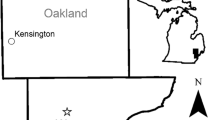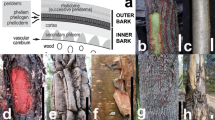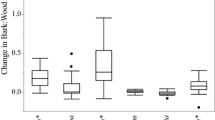Abstract
Bark beetles have recently killed billions of trees, yet conifer defenses are formidable and some trees resist attack. A primary anti-insect defense of pines is oleoresin from a system of resin ducts throughout the tree. Resin defense traits are heritable, and evidence suggests that resin duct characteristics are associated with resistance to insects. However, comparisons of resin ducts in trees killed by bark beetles to trees that resisted attack are unavailable. We compared vertical resin duct characteristics (number, density, and size) and growth rates from trees that were “resistant” (survived mass attack) versus “susceptible” (killed by attack) to bark beetles in lodgepole (Pinus contorta) and limber (Pinus flexilis) pines. Resistant trees of both species had significantly more resin ducts in recent growth than susceptible trees. Discriminant analysis (DA) correctly categorized 84 % of lodgepole and 92 % of limber pines as susceptible/resistant based on combinations of resin duct and growth characteristics from recent 5- through 20-year growth intervals. DA models using measures from only the most recent 5 years of growth correctly categorized 72 and 81 % of lodgepole and limber pines, respectively. Comparing resistant to susceptible trees independent of species identity led to the correct categorization of 82 % of trees based on factors from 5- to 20-year intervals, and 73 % of trees using only resin duct counts from the most recent 5 years. We conclude that resin duct characteristics can be used to assess tree resistance to bark beetles across pine species, and offer a metric for management to enhance pest resistance.





Similar content being viewed by others
References
Allen CD, Macalady AK, Chenchouni H, Bachelet D, McDowell N, Vennetier M, Kitzberger T, Rigling A, Breshears DD, Hogg EH, Gonzalez P, Fensham R, Zhangm Z, Castro J, Demidova N, Lim JH, Allard G, Running SW, Semerci A, Cobb N (2010) A global overview of drought and heat-induced tree mortality reveals emerging climate change risks for forests. For Ecol Manag 259:660–684
Bannan MW (1936) Vertical resin ducts in the secondary wood of the Abietineae. New Phytol 35:11–46
Barton KE, Koricheva J (2010) The ontogeny of plant defense and herbivory: characterizing general patterns using meta-analysis. Am Nat 175:481–493
Benkman CW, Parchman TL (2013) When directional selection reduces geographic variation in traits mediating species interactions. Ecol Evol 3:961–970
Boone CK, Aukema BH, Bohlmann J, Carroll AL, Raffa KF (2011) Efficacy of tree defense physiology varies with bark beetle population density: a basis for positive feedback in eruptive species. Can J For Res 41:1174–1188
Byers JA (1995) Host-tree chemistry affecting colonization in bark beetles. In: Cardé RT, Bell WJ (eds) Chemical ecology of insects 2. Springer, New York, pp 154–213
Carmona D, Lajeunesse MJ, Johnson MT (2011) Plant traits that predict resistance to herbivores. Funct Ecol 25:358–367
Chhatre VE, Byram TD, Neale DB, Wegrzyn JL, Krutovsky KV (2013) Genetic structure and association mapping of adaptive and selective traits in the east Texas loblolly pine (Pinus taeda L.) breeding populations. Tree Genet Genomes 9:1161–1178
Christiansen E, Warning R, Berryman A (1987) Resistance of conifers to bark beetle attack: searching for general relationships. For Ecol Manag 22:89–106
Cornelius J (1994) Heritabilities and additive genetic coefficients of variation in forest trees. Can J For Res 24:372–379
Duhl TR, Gochis D, Guenther A, Ferrenberg S, Pendall E (2013) Emissions of BVOC from lodgepole pine in response to mountain pine beetle attack in high and low mortality forest stands. Biogeosciences 10:483–499
Erbilgin N, Colgan LJ (2012) Differential effects of plant ontogeny and damage type on phloem and foliage monoterpenes in jack pine (Pinus banksiana). Tree Physiol 32:946–957
Faccoli M, Schlyter F (2007) Conifer phenolic resistance markers are bark beetle antifeedant semiochemicals. Agric For Entomol 9:237–245
Fettig CJ, Klepzig KD, Billings RF, Munson AS, Nebeker TE, Negrón JF, Nowak JT (2007) The effectiveness of vegetation management practices for prevention and control of bark beetle infestations in coniferous forests of the western and southern United States. For Ecol Manag 238:24–53
Franceschi VR, Krokene P, Christiansen E, Krekling T (2005) Anatomical and chemical defenses of conifer bark against bark beetles and other pests. Tansley Review. New Phytol 167:353–376
Fuentealba A, Alfaro R, Bauce É (2013) Theoretical framework for assessment of risks posed to Canadian forests by invasive insect species. For Ecol Manag 302:97–106
Gaylord ML, Kolb TE, Wallin KF, Wagner MR (2007) Seasonal dynamics of tree growth, physiology and resin defenses in a northern Arizona ponderosa pine forest. Can J For Res 37:1173–1183
Gaylord ML, Kolb TE, Pockman WT, Plaut JA, Yepez EA, Macalady AK, Pangle RE, McDowell NG (2013) Drought predisposes piñon-juniper woodlands to insect attacks and mortality. New Phytol 198:567–578
Hard JS (1985) Spruce beetles attack slowly growing spruce. For Sci 31:839–850
Hart SJ, Veblen TT, Eisenhart KS, Jarvis D, Kulakowski D (2013) Drought induces spruce beetle (Dendroctonus rufipennis) outbreaks across northwestern Colorado. Ecology. doi:10.1890/13-0230.1
He T, Pausas JG, Belcher CM, Schwilk DW, Lamont BB (2012) Fire-adapted traits of Pinus arose in the fiery Cretaceous. New Phytol 194:751–759
Heil M (2010) Plastic defense expression in plants. Evol Ecol 24:555–569
Heil M, Baldwin IT (2002) Fitness costs of induced resistance: emerging experimental support for a slippery concept. Trends Plant Sci 7:61–67
Herms DA, Mattson WJ (1992) The dilemma of plants: to grow or defend. Q Rev Biol 67:283–335
Hodges JD, Elam WW, Watson WF, Nebeker TE (1979) Oleoresin characteristics and susceptibility of four southern pines to southern pine beetle (Coleoptera: Scolytidae) attacks. Can Entomol 111:889–896
Huberty AF, Denno RF (2004) Plant water stress and its consequences for herbivorous insects: a new synthesis. Ecology 85:1383–1398
Hudgins JW, Franceschi VR (2004) Methyl jasmonate-induced ethylene production is responsible for conifer phloem defense responses and reprogramming of stem cambial zone for traumatic resin duct formation. Plant Physiol 135:2134–2149
Kane J, Kolb TE (2010) Importance of resin ducts in reducing ponderosa pine mortality from bark beetle attacks. Oecologia 164:601–609
King JN, Alfaro RI, Grau Lopez M, VanAkker L (2011) Resistance of Sitka spruce (Picea sitchensis) to white pine weevil (Pissodes strobi): characterizing the bark defence mechanisms of resistant populations. Forestry 84:83–91
Kolosova N, Bohlmann J (2012) Conifer defenses against insects and pathogens. In: Schnyder H, Oßwald W (eds) Growth and defense in plants: resource allocation at multiple scales, vol 220. Springer, Berlin, pp 85–109
Koricheva J (2002) Meta-analysis of sources of variation in fitness costs of plant anti-herbivore defenses. Ecology 83:176–190
Lerdau M, Litvak M, Monson R (1994) Plant chemical defense: monoterpenes and the growth-differentiation balance hypothesis. Trends Ecol Evol 9:58–61
Linhart YB, Mitton JB (1985) Relationships among reproduction, growth rates, and protein heterozygosity in ponderosa pine. Am J Bot 72:181–184
Loehle C (1988) Tree life history strategies: the role of defenses. Can J For Res 18:209–222
Martin D, Tholl D, Gershenzon J, Bohlmann J (2002) Methyl jasmonate induces traumatic resin ducts, terpenoid resin biosynthesis, and terpenoid accumulation in developing xylem of Norway spruce stems. Plant Physiol 129:1003–1018
McDowell NG, Adams HD, Bailey JD, Kolb TE (2007) The role of stand density on growth efficiency, leaf area index, and resin flow in southwestern ponderosa pine forests. Can J For Res 37:343–355
Meddens AJH, Hicke JA, Ferguson CA (2012) Spatial and temporal patterns of observed bark beetle-caused tree mortality in British Columbia and the Western US. Ecol Appl 22:1876–1891
Mitton JB, Ferrenberg SM (2012) Mountain pine beetle develops an unprecedented summer generation in response to climate warming. Am Nat 179:E163–E171
Mooney KA, Halitschke R, Kessler A, Agrawal AA (2010) Evolutionary trade-offs in plants mediate the strength of trophic cascades. Science 327:1642–1644
Moreira X, Alfaro RI, King JN (2012) Constitutive defenses and damage in Sitka spruce progeny obtained from crosses between white pine weevil resistant and susceptible parents. Forestry 85:87–97
Mumm R, Hilker M (2006) Direct and indirect chemical defence of pine against folivorous insects. Trends Plant Sci 11:351–358
Muola A, Mutikainen P, Laukkanen L, Lilley M, Leimu R (2010) Genetic variation in herbivore resistance and tolerance: the role of plant life-history stage and type of damage. J Evol Biol 23:2185–2196
Neale DB, Savolainen O (2004) Association genetics of complex traits in conifers. Trends Plant Sci 9:325–330
O’Neill GA, Aitken SN, King JN, Alfaro RI (2002) Geographic variation in resin canal defenses in seedlings from the Sitka spruce × white spruce introgression zone. Can J For Res 32:390–400
Raffa KF, Aukema BH, Erbilgin N, Klepzig KD, Wallin KF (2005) Interactions among conifer terpenoids and bark beetles across multiple levels of scale: an attempt to understand links between population patterns and physiological processes. Recent Adv Phytochem 39:79–118
Raffa KF, Powell EN, Townsend PA (2013) Temperature-driven range expansion of an irruptive insect heightened by weakly coevolved plant defenses. Proc Natl Acad Sci USA 110:2193–2198
Reid RW, Whitney HS, Watson JA (1967) Reactions of lodgepole pine to attack by Dendroctonus ponderosae Hopkins and blue stain fungus. Can J Bot 45:1115–1126
Rosner S, Hannrup B (2004) Resin canal traits relevant for constitutive resistance of Norway spruce against bark beetles: environmental and genetic variability. For Ecol Manag 200:77–87
Ruel J, Whitham TG (2002) Fast-growing juvenile pinyons suffer greater herbivory when mature. Ecology 83:2691–2699
Sampedro L, Moreira X, Zas R (2011) Resistance and response of Pinus pinaster seedlings to Hylobius abietis after induction with methyl jasmonate. Plant Ecol 212:397–401
Smith RH (2000) Xylem monoterpenes of pines: distribution, variation, genetics, function. US Department of Agriculture, Forest Service, Pacific Southwest Research Station
Strom BL, Goyer RA, Ingram LL, Boyd GDL, Lott LH (2002) Oleoresin characteristics of progeny of loblolly pines that escaped attack by the southern pine beetle. For Ecol Manag 158:169–178
Westbrook JW, Resende MF, Munoz P, Walker AR, Wegrzyn JL, Nelson CD, Neale DB, Kirst M, Huber DA, Gezan SA, Peter GF, Davis JM (2013) Association genetics of oleoresin flow in loblolly pine: discovering genes and predicting phenotype for improved resistance to bark beetles and bioenergy potential. New Phytol 199:89–100
Wimmer R, Grabner M (1997) Effects of climate on vertical resin duct density and radial growth of Norway spruce (Picea abies L. Karst). Trees 11:271–276
Wright SJ, Kitajima K, Kraft NJ, Reich PB, Wright IJ, Bunker DE, Condit R, Dalling JW, Davies SJ, Díaz S, Engelbrecht BMJ, Harms KE, Hubbell SE, Marks CO, Ruiz-Jaen MC, Salvador CM, Zanne AE (2010) Functional traits and the growth-mortality trade-off in tropical trees. Ecology 91:3664–3674
Zust T, Joseph B, Shimizu KK, Kliebenstein DJ, Turnbull LA (2011) Using knockout mutants to reveal the growth costs of defensive traits. Proc R Soc Lond B 278:2598–2603
Acknowledgments
We thank Boulder County Parks and Open Space, the Indian Peaks Wilderness Alliance, the John Marr Ecology Fund, and the University of Colorado’s Department of Ecology and Evolutionary Biology for awards to SF. Additional support was provided by Department of Energy grant DE-FG02-07ER64457. Our manuscript was improved by comments from three anonymous reviewers.
Author information
Authors and Affiliations
Corresponding author
Additional information
Communicated by Russell K. Monson.
Rights and permissions
About this article
Cite this article
Ferrenberg, S., Kane, J.M. & Mitton, J.B. Resin duct characteristics associated with tree resistance to bark beetles across lodgepole and limber pines. Oecologia 174, 1283–1292 (2014). https://doi.org/10.1007/s00442-013-2841-2
Received:
Accepted:
Published:
Issue Date:
DOI: https://doi.org/10.1007/s00442-013-2841-2




